Hi all!
I am a sourdough newbie--started out last year with a starter gifted to me by a friend, had one success and a couple of major flops, then life got in the way and I neglected my starter. Long story short, I've decided to start again, and grew my own starter this time based on Maurizio's instructions in The Perfect Loaf ( https://www.theperfectloaf.com/7-easy-steps-making-incredible-sourdough-starter-scratch/ ). The starter is pretty new, about two and a half or three weeks old, but is consistently tripling. I feed it twice a day at 100% hydration. I live in Texas and it is HOT indoors these days--ambient temp around 82-84 degrees in the mid-afternoon. I've got my starter on a pretty good schedule with colder water and 15g carryover starter to 100g flour and water.
I did my first bake yesterday, using Maurizio's beginner's sourdough loaf ( https://www.theperfectloaf.com/beginners-sourdough-bread/# ). I let bulk fermentation go on for a full four hours, even though it was around 82 degrees, because I couldn't see many bubbles (wasn't using a clear container so only had the top to go by), and I was terrified of underproofing. Had some issues shaping so the loaf is a bit lopsided. Retarded in the fridge for 16 hours. I'm happy with the bake for a first try--it tastes great and got some oven spring, more than had happened with a couple of the loaves I tried last year--but I noticed some density issues with the crumb. Parts of it are really holey and open, and other parts feel packed tight, and I didn't get as much rise I would have wanted (although it didn't seem to collapse and spread out, either). Problem is, for the life of me I can't tell if it's over- or underproofed, and can't decide if next time I should cut bulk fermentation or add to it! The heat makes me think I let bulk go on too long, but I just can't tell for sure.
Any thoughts would be greatly appreciated! I'm including some pictures of the loaf for reference. 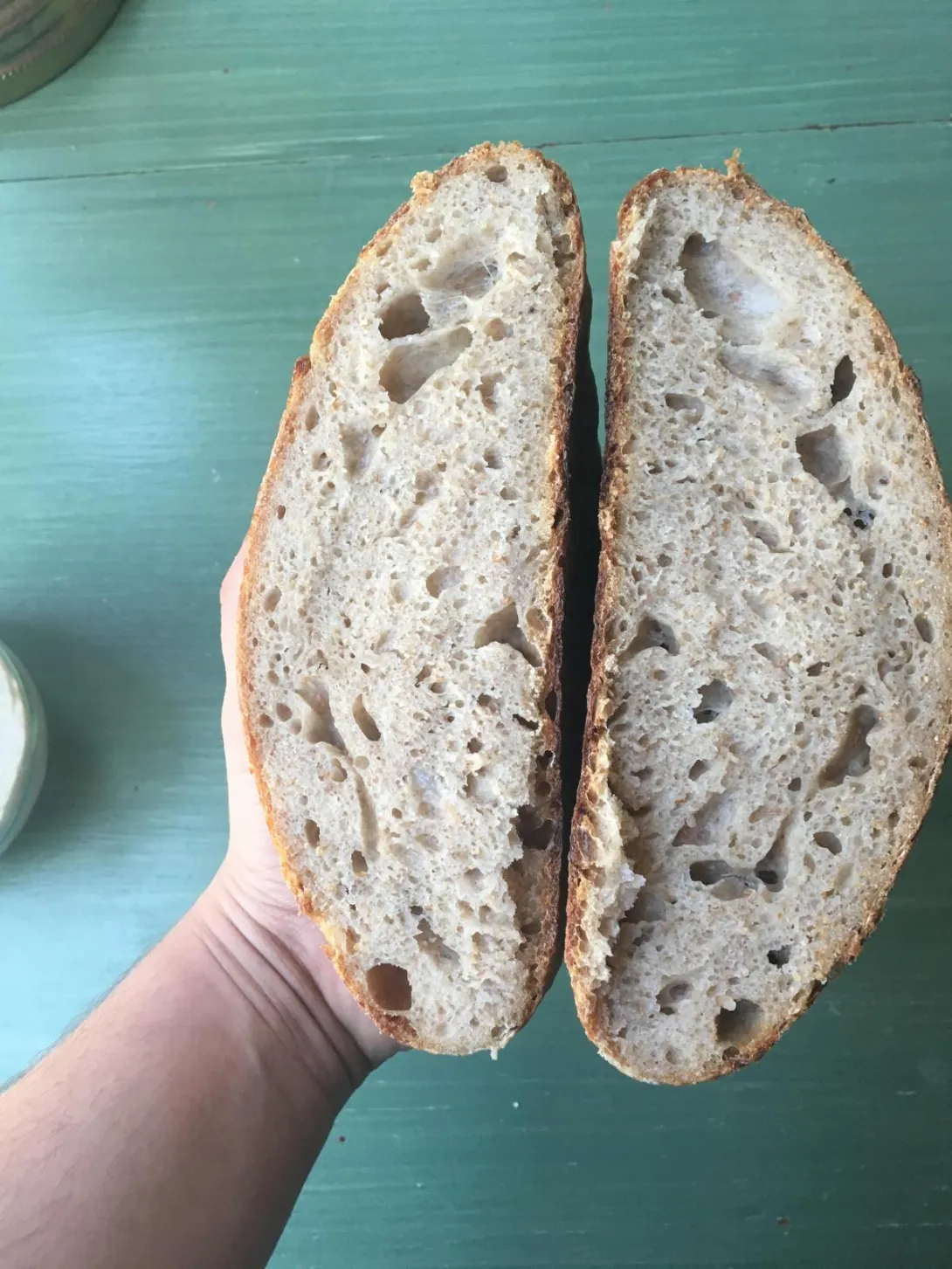
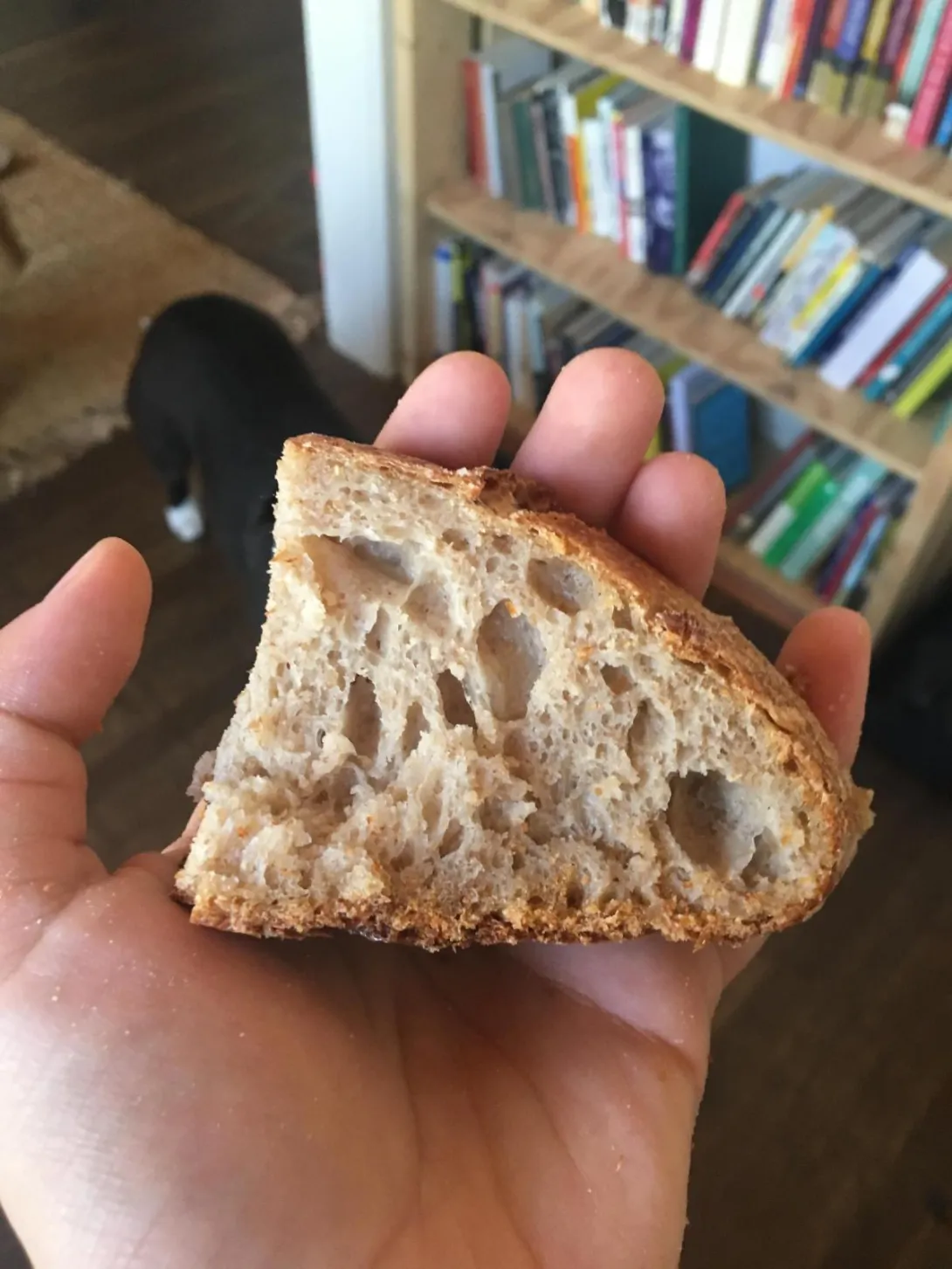
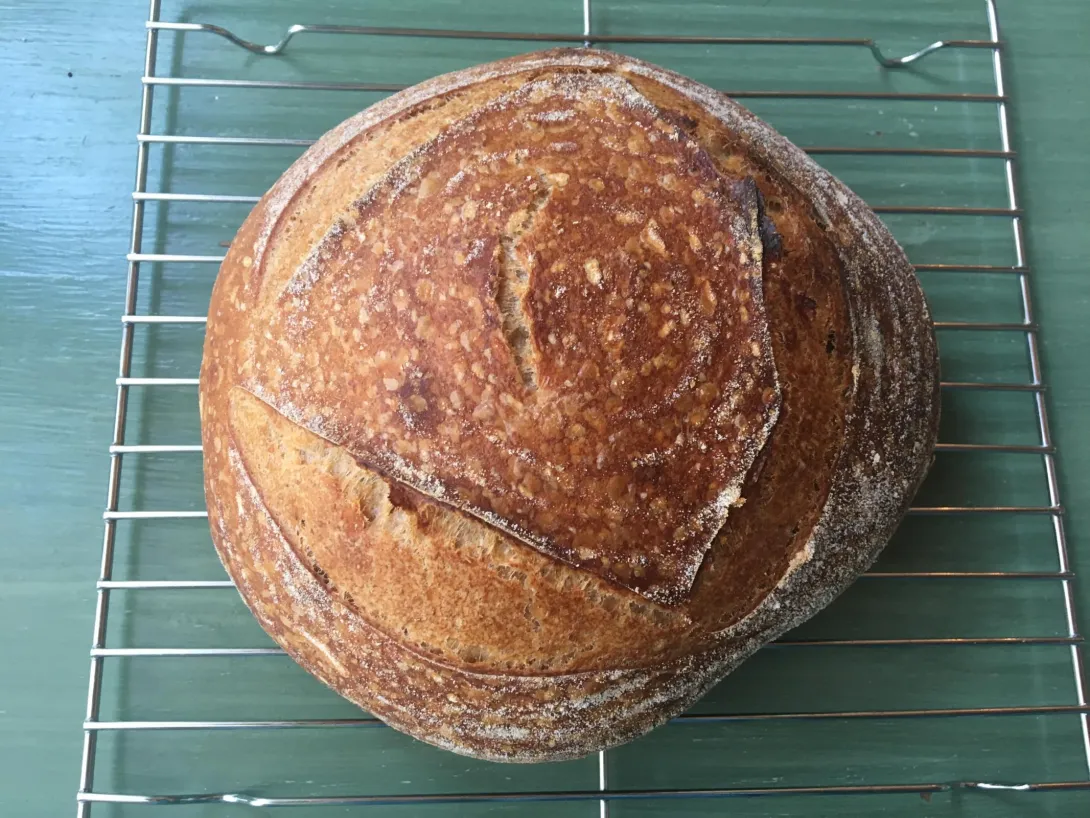
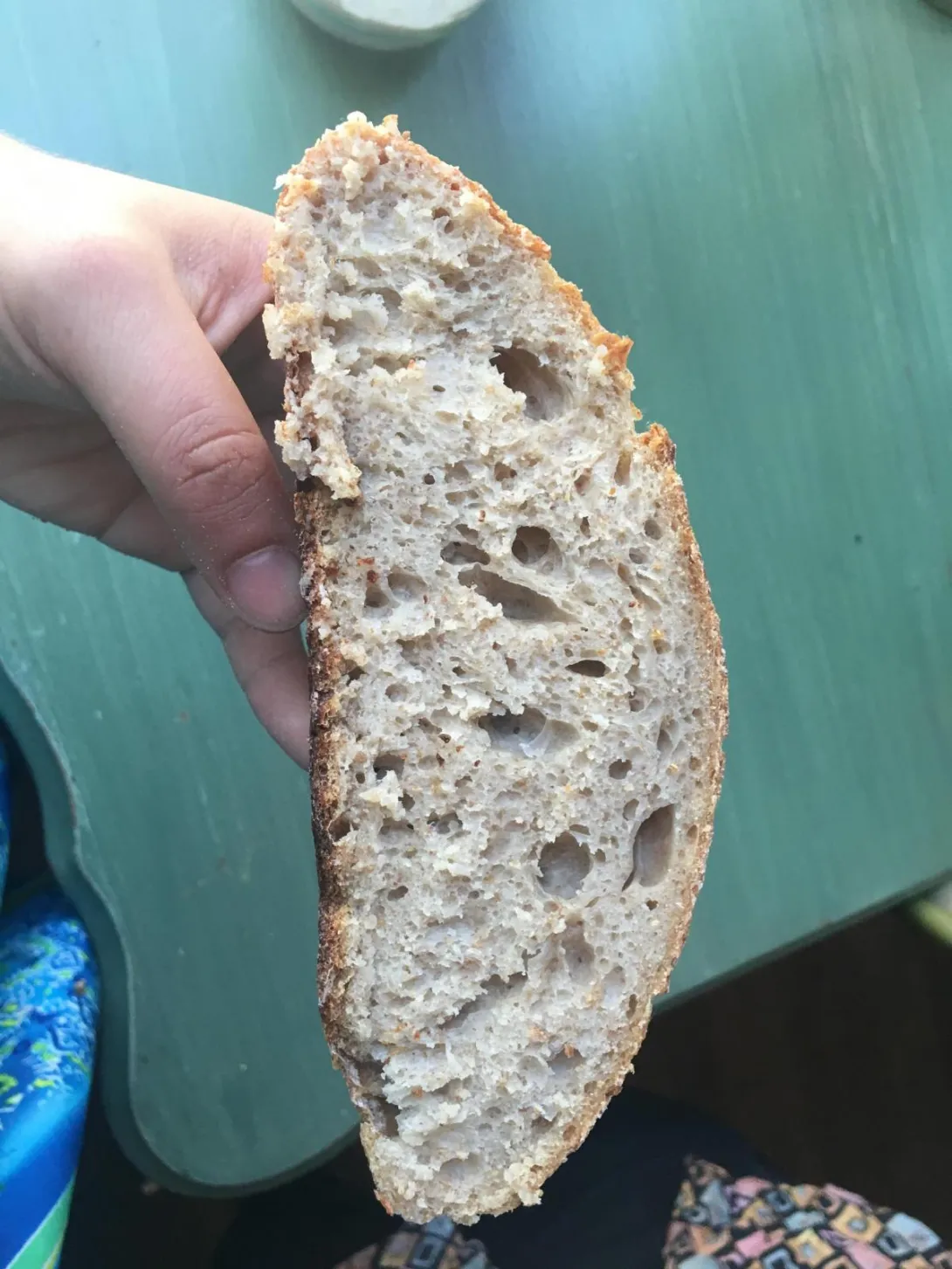
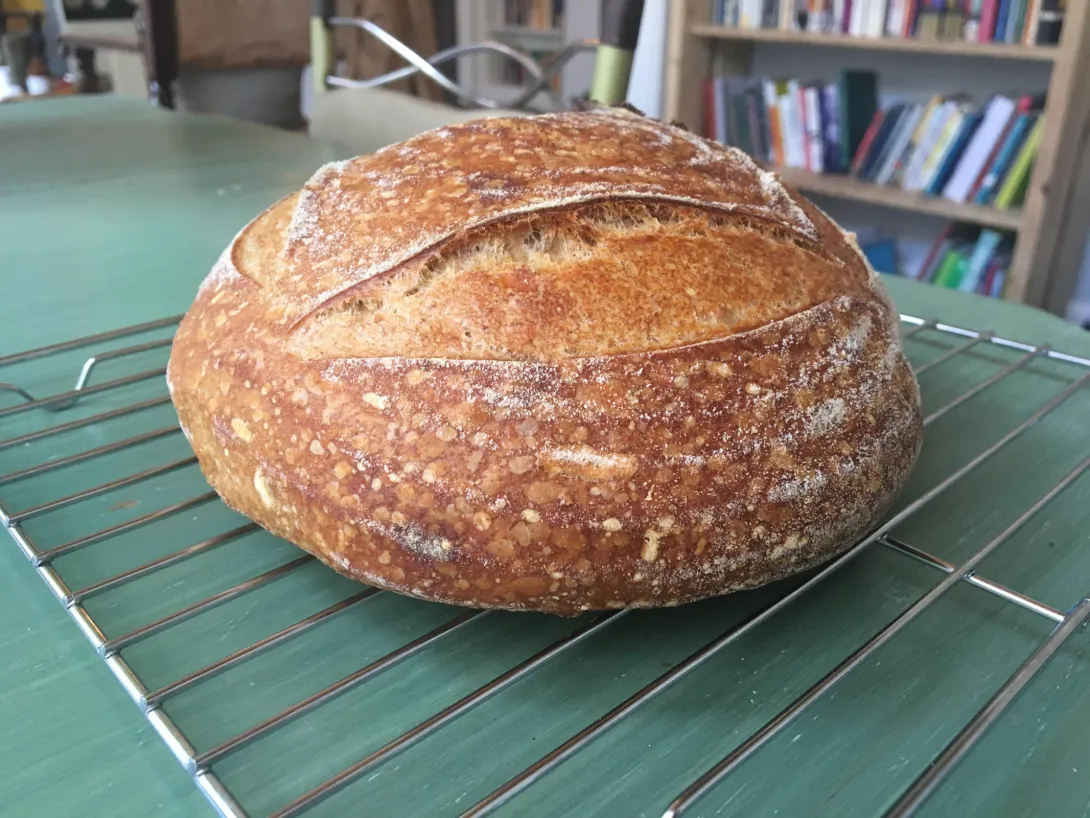
Maurizio may tout this as a “beginner's” sourdough loaf, but it’s not. It’s high hydration and I had oh-so-many-issue with it, and a flat loaf just about every time I followed his recipe. Here’s how I adjusted the recipe to make it work better—maybe it will work for you:
(1) Remove the extra 50g water required at the mixing-in-salt stage. Just wet your hands and the dough. Less water, better dough
(2) Instead of mixing in the starter with the salt and dough, mix it in with the water when you create the dough (flour and water mix). I’ve tried both ways to add starter, and dissolving in water for flour/water mix is easier and, I think, better. Autolyse for at least an hour—a little more if you can.
(3) Do a few folds when you mix in the salt. In fact, give it a few minutes of knead-like folds when you mix in the salt to kinda get the gluten going.
(3) Do four folds. Three is not enough.
That should help. Most of all, it SHOULD NOT BE STICKY when it comes time to shape it. It should be tacky only and easy to shape. If it is sticky, don’t be afraid to dust it with flour till you can really shape it all tight and round.
Let us know if that helps at all. If it still comes out flat—and it may, and you have to make it again (it’s frustrating but I had to do it like 10 times before it came out right), try turning down the oven from 500 to 475.
Alternately: switch to this guy’s recipe
https://youtu.be/APEavQg8rMw
A lot of the people here swear by him. I haven’t tried him yet, but honestly, if I’d found him first, I’d have gone with him instead of Maurizio. Maurizio’s bread tastes awesome and he’s super nice (I actually emailed him and he was the one told me to cut down on the hydration), but I’m not sure his website is the best for novices.
That video is amazing! Then I clicked on his icon, of course, he's a sensation and successful, he's good! And I'm such a sucker for a man with an accent (my husband is from Croatia).
This is so comforting to hear!! Thank you for all this information. I'm definitely going to try your adjustments next time, and will also probably try following that video to see if I have any better luck.
Thank you!
You’re far from alone. I’ve read something like four other posts on this forum from novices using the same recipe and having the same problem. That said, overproofing or underproofing sourdough is super common no matter the recipe, especially for us novices.
After reading your post, my focus is towards your starter. Your feeding of 15 starter + 100 water + 100 flour @ 82-84F sounds off. At that warm temperature, I’m not sure you can get any 100% starter to last for 12 hours. It will over ferment. I have never seen a 100% starter using white flour triple. A wet starter (100%) doesn’t have enough gluten strength to hold the gas necessary to enable such a large rise. Maybe the cold water is helping, I have no experience with that.
If you post images, that would be a great help.
When a 12 hour starter feed cycle is your goal, a drier starter is your best choice. Drier starters take longer to rise and the gluten is strong enough to allow very high rises.
Tell is everything you can about your starter. I’m sure we can help. Let’s make sure your starter is healthy and active.
Does your bread taste sour?
Danny
Danny, I would definitely love any help I can get with this starter in such high temperatures! I keep fiddling around with it, trying to get it to peak at 12 hours during the day, but haven't had much success. At night when the temp gets down to 74 or 75 it does great with 18:100:100, room temp water, and a mixture of 75 g AP flour, 25g rye.
I was originally feeding it 50/50 AP and rye with 20g starter, and that's when it was tripling--the bubbles also were more defined. In the photos below it had not yet peaked, and continued to rise a couple of inches:
I recently switched to 75 AP, 25 rye in an attempt to slow it down some--it's now rising a little less. This morning I fed it around 11 am, and I just got home and it had peaked and begun to fall. Oy. The coolest place in my house is 86 degrees at the moment. This is what it looks like:
So in summary, my routine recently has been 20 starter:25 rye:75 AP: 100 room temp water in the evenings, and 15 starter:25 rye:75 AP: 100 cool water in the mornings--but it's still peaking too early on me during the day. Should I start feeding it twice during the day and once at night? I'm a bit at a loss.
In terms of the bread, it tasted a little bit sour, but not intensely so.
Any thoughts you have would be much appreciated, and let me know if there's any more info that might help!
Abi
Had another question I forgot to post. Should I always be feeding my starter right at its peak? Or is it all right to feed it after it has fallen a couple of inches?
Thank you again!
Abi, your starter looks very active. If you are willing, make another starter and keep your original. This will enable a test without disturbing your original starter.
If you have a small (6-8 oz) straight sided clear glass, that would be ideal. Mix 10g starter + 30g water + 50g flour (1:3:5). All purpose or bread flour is good. After you mix it, knead it until the gluten is formed. Push the dough ball into the bottom of your glass. Mark the level of the dough with a sharpie. NOTE - ink comes easily off of glass when rubbed with a pot scrubber. It’s handy because you can write other info, such as time, feed ratios, ect..
Photograph the starter and let us know how things go.
You’ve got a good starter already. We’re just trying to control things better. The goal is a 12 hr (2 x day) feedings. Ideally, the starter should reach maximum rise and then barely begin to recede. If your starter falls for too long a time, the bacteria (LAB) will begin to dominate and the yeast will diminish.
This new starter will behave much more differently. The rye (and any whole grains) will greatly increase the speed of the starter’s maturity. In your case (83F) you want to slow things down.
Utilizing all of the knowledge from the experienced bakers on this site will have you baking good SD in short order. We are all here to help.
Danny
NOTE - I didn’t initially realize that you were using rye, maybe whole grain rye. I was thinking 100% hydrated white flour. Whole grains at 100% hydration are a different matter. They will be drier.
Great advice!! Thanks so much. I'm going to start this second starter when I feed my first tonight. Will post photo updates!
I followed your advice and started a second starter at 60% hydration--I think it's going well but it's behaving really differently! I'm assuming that when the top goes from convex to concave, it's peaked? I'm including a couple of pictures here after 12 hours, at what I'm guessing is around the peak:
Starter number 1 is continuing to rise and fall too fast, so I've lowered it's hydration to 80% and am going to move it on over to the fridge, since I only plan to use on the weekends. I built a levain with it at its peak this morning and am going to try out that youtube video Jey posted to see how it goes. Will keep you all updated!
Abi, your latest images look much better to me. How much starter and water and flour did you feed it?
What do you estimate the temperature of the room to be?
I fed at the proportions you recommended -- 10g mature starter, 50g AP flour, 30g water. The temp ranged from 79-86 throughout the day and the starter seemed to move nice and slow, peaking right about where I wanted it to!
For Starter 1 that I put in the fridge, I did 20g mature starter, 100g bread flour, and 80g water. Let it rest until I saw it had started to rise a bit and then put it in the fridge. So I'll keep an eye on that and see how it's doing.
Currently in the bulk fermentation stage of this new loaf I'm working on (made from starter 1 with a 100% hydration bread flour levain), and can't really tell how well it's rising. But bulk is always tricky for me!
Will keep you updated!
I have been trying to reactive my starter from dried (as I was away for the a lot of the summer) and usually use a mixture of w/wheat and 10% rye to do so (I don't use bread flour as I live in Indonesia and am not sure the bread flour I use would be great for the starter). I have done this before but for some reason my starter wasn't very happy this time; it was just about doubling but not very active despite everything being the same as previously.
I tried using your ratio just out of curiosity and it's more than doubled in 12 hours and still hasn't dropped back yet. I have a question that I hope you don't mind answering though:
- If I needed a 100% hydration starter for a recipe is there any reason that I couldn't just change the ratios when I feed it?
Lady C. You can change grains, flours and/or hydrations at will. If a rye starter is needed you can feed a white starter rye and convert it from one feeding to the next. A 60% starter can be converted to 125% starter in 1 feeding. At least that has been my experience.
The reason I keep a dry starter is because it is refreshed every 12 hours. I Never could get a 100% starter to go 12 hours without over fermenting. A wet starter is fine when refrigerating, though.
Keep in mind that people have very different ideas about all things concerning starters. So other experienced bakers may have very different opinions. Experiment and use what works for you.
Danny
I've been reading a fair amount about SD over the past few months and suspected that I could change hydration at will to fit the recipe I'm working with but it's nice to have that confirmation. :-)
My wet starter doesn't do well in the fridge - after about 5/6 days it develops a layer of, what I believe is, kham yeast and it's such a pain to scrape that layer off, especially as I only keep a very small amount of starter going in between bakes.
Oh, that’s another adjustment! An important one. The recipe says 1:2:2 ratio for 6 hours as the levain to make the bread. If, that is, you follow the schedule.
Instead, go for a 12 hour levain. Make it the evening before at 1:10:10. Use 50/50 wheat and bread flour for it. Evenings are cooler, too, so you should be at “peak” 12 hours later, unlike during the hot day time hours. And it should be strong enough and with enough gluten to make the good bread (we hope).
As for your starter, I would keep it in the refrigerator until you want to make bread. Unless you’re making bread daily, there’s no reason to keep it out all the time.
This makes so much sense. Thank you!! I was thinking about putting it in the fridge but was worried it was still too new--but since it's hyperactive it sounds like a good idea. I only really plan to bake on the weekends.
If you can make bread from it, you can refrigerate it. Take it out the day before (like Friday), let it sit on the kitchen counter for about an hour to thaw, then give it a 1:1:1 (or 1:2:2 or 1:4:4) feeding of it's regular food to "wake it up." Then that evening, you can create the super-strong levain (wheat/BF 1:10:10) for the next day's bake...and put the remaining starter back in the fridge unfed.
You'll probably have left over levain after you make the bread. At that point, you can decide if you want to make that left over into your new starter (because it bubbled up so well?) and put that in the refrigerator (getting rid of the old starter) or if you want to get rid of the left-over levain and just keep to the old starter in the refrigerator.
Or you can always dehydrate the left over levain—it's a good idea to have some dehydrated starter in a jar in case you ever run out or it goes wrong. It's easier and faster to recreate starter from dehydrated starter than recreating it from scratch.
Here's how: https://www.youtube.com/watch?v=P_hR43eMgug
And check out this video for the penultimate aim of waste-less sourdough bread making:
https://youtu.be/Uj6YpNCUYYQ
...I'd like to say I'm doing this, but I'm not yet confident enough in my starter. I feel it does need to be "woken up" with a feeding before it's ready to make bread.
These links are awesome! Thank you! I think my starter is going to go for a little stay in the fridge.
All right, round two!! I made a new loaf (two 600g boules, actually) using Alex's youtube video that Jey posted. I did slap and folds for 20 minutes instead of 10, as that seemed to be how long it took for the gluten to really develop. I used my 100% hydration starter (fed with AP and rye) and made a 100% hydration levain using Alex's instructions (2 tablespoons starter, 100g water, 100g bread flour). My levain took a little longer than his to peak (his took 4:45, mine took around 6 hours). Autolysed 200g levain, 400 g water, and 600 g bread flour for 30 minutes. Added a splash of water, 12g salt, S&F for 20 min. FDT was 82 degrees, and it was about 84 degrees in my house at the time. Let bulk fermentation go on for around 4:45 (he said 4 hours, but mine seemed to be taking a little longer), and got about a 40% rise during bulk--somewhere around there, it was hard to tell exactly. No stretch and folds during bulk, as it was feeling good from my slap and folds previously. Pre-shaped and shaped (the dough felt super easy to work with, no sticky mess like my previous attempts), and retarded overnight in the fridge, about 13 hours total. Did a final room-temp proof for two hours, and baked! SO much happier with these results. Tons of oven spring, nice dark crust, and the crumb appears ... decent, at least? (It's still hard to tell, so correct me if I'm wrong!) Bread tastes nice and mild, a little tangy but no overwhelming sourness.
Would love to hear any thoughts on my loaf/the crumb and any suggestions for next time!
Thank you all so much for your help!!
WOW, the improvement is remarkable! You must be ecstatic.
I recommend you bake this same loaf again to compound the success. Confidence is a powerful asset.
Fantastic...
Danny
I could not have done it without all your and Jey's help!!! Thank you!! I am thrilled.
My contribution was just to point out his video—which was pointed out to me here on this forum by someone else. Which means you'll get to point it out to someone else :-D
And OMG, those loaves are PERFECT. Beautiful oven spring, beautiful crust, beautiful crumb. Congratulations. and I'm so glad you had that success. I know how frustrating that sticky dough is, and those flat loaves! And I know how relieved you can feel when you finally handle dough that isn't sticky, "Oh, THAT's what it's supposed to be like!" And then to open up that oven and see a loaf all puffed up and caramelized like it ought to be...Blissful sigh!
So, here are some well earned pats on the back and cheers: You did it! You baked your own sourdough loaf. And I hope you've posted those pictures all over the place—especially where friends and family can ooo and ahhh over them?
Enjoy the bread—and if it doesn't all get eaten, slice up the remainder, lie the slices down flat on foil, wrap them up and put them in the freezer. When you want some, just pop them into the toaster and they'll come up almost as good as those slices that were fresh from the oven.